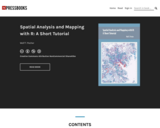
This tutorial introduces the reader to some of the amazing capabilities of R to work with and map geographic data. Geographic data are data that contain spatial attributes (or spatial data) that define a geographic space (location, area, elevation, etc.) and non spatial attributes (f.e., population density, pollutant concentrations, temperature).
This tutorial was developed for one the units of the course “ENVS 420: Research Seminar in Environmental Sciences” offered at the University of Baltimore. However, it is hoped that readers outside of ENVS 420 who are interested in geospatial analysis and with a basic familiarity of R find this tutorial useful.
The use of an integrated developer environment (IDE) or an IDE like configuration such as the IDE RStudio (https://rstudio.com/) or the Nvim-R plug-in for the integration of vim/neovim and R (https://github.com/ jalvesaq/Nvim-R/tree/stable) is recommended but not necessary.
The tutorial was written with RMarkdown (v. 2.6) (Allaire et al., 2020; Xie et al., 2018, 2020) in R (v. 4.2.3) (R Core Team, 2020).
- Subject:
- Applied Science
- Cultural Geography
- Diversity, Equity and Inclusion
- Environmental Science
- Environmental Studies
- Geography
- Life Science
- Mathematics
- Physical Science
- Professional Development
- Social Science
- Statistics and Probability
- Material Type:
- Activity/Lab
- Data Set
- Diagram/Illustration
- Unit of Study
- Author:
- Wolf T. Pecher
- Date Added:
- 05/10/2021